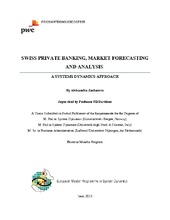| dc.description.abstract | The Swiss private banking industry has been always known as one of the leading off-shore private banking centers. During the last five years, however, the market entered a phase of fundamental change. Global economic downturn has notably harmed the industry and the natural recovery was further depressed with the new regulations coming into force. This thesis is an empirical study of the System Dynamics methodology applied to analyze the Swiss private banking industry in its transition phase. The aim of this thesis is to develop a System Dynamics model that can act as a helpful tool for identifying important structural changes in the industry and assisting in developing industry forecasts. First, this paper provides a review of the relevant literature that proves the adequacy of the chosen methodology for the Swiss private banking case. Then, a detailed description of the development of the industry over time is presented, followed by the hypothesis that suggests that the behavior of the industry has been largely driven by the external factors and the not-so-invisible-hand" represented by the new regulations. The last section of thesis is devoted to the analysis of the market in the short-midterm future under various scenarios. The results of the study demonstrate that policies that are being implemented by private banks, directed at cost reduction, are effective only to a very limited extent. It is suggested that only by combining operational efficiency and cutting costs with improved overall service and product quality, Swiss private banks will be able to achieve the positive trend in the profitability of the industry in a midterm future. The key contribution of this work includes a model that captures the private banking industry in a structured systemic way that includes time delays, feedback cycles, nonlinearities, and stocks and flows. The conclusive added value of this model is its ability to forecast the development of key industry indicators under various scenarios. | en_US |
